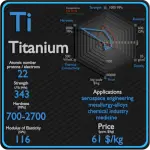This article contains comparison of key thermal and atomic properties of beryllium and aluminium, two comparable chemical elements from the periodic table. It also contains basic descriptions and applications of both elements. Beryllium vs Aluminium.

Beryllium and Aluminium – About Elements


Source: www.luciteria.com
Beryllium and Aluminium – Applications
Beryllium
Berylium can be utilized as alloying agent in production of beryllium-copper, X-ray detection diagnostics, manufacture of computer peripherals, in nuclear reactors as neutron moderators and reflectors. 80% of the beryllium used goes into copper beryllium alloys. The combination of light weight with high strength at extreme temperatures makes beryllium metal and aluminium beryllium alloys ideal for use in high performance aerospace applications such as components of rockets. Transparency to x-radiation makes pure beryllium metal essential in security equipment and high-resolution medical imaging technology, such as mammography to detect breast cancer. Copper beryllium is the hardest and strongest of any copper alloy (UTS up to 1,400 MPa), in the fully heat treated and cold worked condition. It combines high strength with non-magnetic and non-sparking qualities and it is similar in mechanical properties to many high strength alloy steels but, compared to steels, it has better corrosion resistance.
Aluminium
Aluminium and its alloys are used widely in aerospace, automotive, architectural, lithographic, packaging, electrical and electronic applications. It is the prime material of construction for the aircraft industry throughout most of its history. About 70% of commercial civil aircraft airframes are made from aluminium alloys, and without aluminium civil aviation would not be economically viable. Automotive industry now includes aluminium as engine castings, wheels, radiators and increasingly as body parts. 6111 aluminium and 2008 aluminium alloy are extensively used for external automotive body panels. Cylinder blocks and crankcases are often cast made of aluminium alloys.
Beryllium and Aluminium – Comparison in Table
| Element | Beryllium | Aluminium |
| Density | 1.848 g/cm3 | 2.7/cm3 |
| Ultimate Tensile Strength | 345 MPa | 90 MPa (pure), 600 MPa (alloys) |
| Yield Strength | N/A | 11 MPa (pure), 400 MPa (alloys) |
| Young’s Modulus of Elasticity | 287 GPa | 70 GPa |
| Mohs Scale | 5.5 | 2.8 |
| Brinell Hardness | 600 MPa | 240 MPa |
| Vickers Hardness | 1670 MPa | 167 MPa |
| Melting Point | 1278 °C | 660 °C |
| Boiling Point | 2469 °C | 2467 °C |
| Thermal Conductivity | 200 W/mK | 237 W/mK |
| Thermal Expansion Coefficient | 11.3 µm/mK | 23.1 µm/mK |
| Specific Heat | 1.82 J/g K | 0.9 J/g K |
| Heat of Fusion | 12.2 kJ/mol | 10.79 kJ/mol |
| Heat of Vaporization | 292.4 kJ/mol | 293.4 kJ/mol |
















